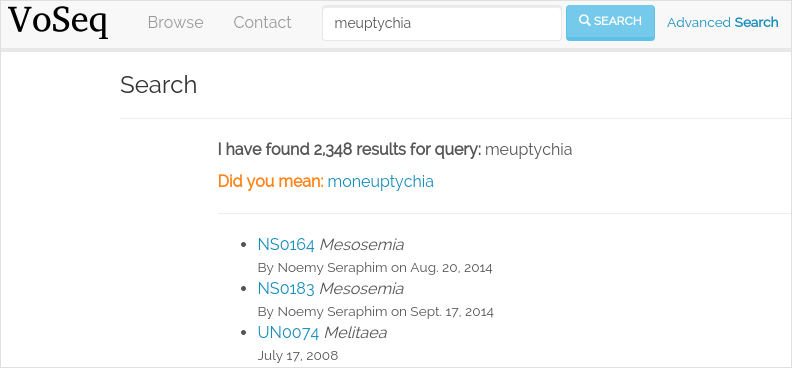| Windows | Linux |
|---|---|
- VoSeq is being rewritten
- New features
- Installation instructions
- Test database for development
- Start a test server
- Migrate VoSeq database
- Set-up a publicly available web server
- Administrate the server
We are rebuilding VoSeq from scratch. We decided to migrate from PHP to Python by using the framework Django. We also moved from MySQL to PostgreSQL.
You can still download the old VoSeq v1.7.4 from here. But be aware that we will not be doing major maintenance of that code.
Here is a test installation of the old VoSeq (v1.7.0) http://www.nymphalidae.net/VoSeq/
More details about the migration can be found in our discussion list.
VoSeq 2.0.0 is the future!
Query suggestions for simple taxon searches:
These instructions assume that your libraries are up to date and that you have Python, pip, Java 7+ and virtual environments installed. Python3 is recommended.
Step 1: get VoSeq. Clone or download VoSeq to your prefered directory.
Step 2: create a virtual environment and install dependencies. To ensure that all the dependancies will work without conflict, it is best to install them within a virtual environment.
mkvirtualenv -p /usr/bin/python voseq_environment
cd /path/to/VoSeq
workon voseq_environment
pip install -r requirements/testing.txtExit the virtual environment for now to continue from the shell:
deactivateStep 3: download and install elasticsearch. For elasticsearch, java needs to be installed. Mac users can download and install elasticsearch from here: http://www.elasticsearch.org/overview/elkdownloads/ . In Linux, you can do:
wget https://download.elastic.co/elasticsearch/elasticsearch/elasticsearch-1.5.2.deb
sudo dpkg -i elasticsearch-1.5.2.debThe bin directory of elasticsearch should be added automatically to your PATH. If not, add the following line to your .profile (Linux) or .bash_profile (macOSX) file:
export PATH="$PATH:/parth/to/elasticsearch/bin/"Step 4: download, install and configure PostgreSQL. For macOSX users we recommend to do it by downloading the Postgres.app from http://postgresapp.com . Linux users can use apt-get:
sudo apt-get install postgresql postgresql-contrib postgresql-server-dev-9.3Create new role by typing:
createuser --interactiveEnter the psql shell, create a password for this user and create a database for VoSeq:
psql
postgres=# ALTER ROLE postgres WITH PASSWORD 'hu8jmn3';
postgres=# create database voseq;In macOSX if you are using the Postgres.app, it my be enough to run:
psql
user.name=# CREATE DATABASE voseq;To exit the psql shell:
\qNext, create a config.json file to keep the database variables:
cd /path/to/Voseq
touch config.jsonand write in the following content:
{
"SECRET_KEY": "create_a_secret_key",
"DB_USER": "role_name",
"DB_PASS": "create_a_database_password",
"DB_NAME": "voseq",
"DB_PORT": "5432",
"DB_HOST": "localhost",
"GOOGLE_MAPS_API_KEY": "get_a_google_map_api_key"
}If you followed the above instructions to the letter, the DB_USER will be "postgres" and the DB_PASS will be "hu8jmn3". It is of recommended to come up with your own password. Instructions to obtain a personal google map browser API key can be found here.
After following these four steps everything should be installed and ready to run. You can now choose to either continue with adding real data migrated from VoSeq 1.x and setting up a publicly available web server, or to first add some test data and test the set-up with a lightweight local server included in the VoSeq package.
You can use test data to populate your PostgreSQL database, useful for development.
First, enter the virtual environment:
workon voseq_environmentThen, create tables for the database:
cd /path/to/Voseq/
make migrationsAnd import test data for your database:
make test_importIn Linux start elasticsearch as a service, then enter the virtual environment and then start the server:
sudo service elasticsearch start
workon voseq_environment
cd /path/to/Voseq
make serveIn macOSX if you do not have the service command, run elasticsearch in the background and then start the server (*):
elasticsearch -d
cd /path/to/Voseq
make serve* Note that if you did not check to Start Postgres automatically after login, you first have to go to Applications and start it manually from there by clicking on the Postgres.app. Do this before running the server.
You now have a local webserver running. You can access it by opening this URL in your web browser: http://127.0.0.1:8000/ and try all the buttons to see if they all work! Also notice the debug bar on the right of the screen where you can check if all the configurations are correct.
If you have an existing Voseq 1.x database and want to migrate, you need to dump your MySQL database into a XML file:
cd /path/to/Voseq/
mysqldump --xml voseq_database > dump.xmlThen use our script to migrate all your VoSeq data into a PostGreSQL database.
make migrations
python voseq/manage.py migrate_db --dumpfile=dump.xml --settings=voseq.settings.localIf you have used a prefix for your tables in the old VoSeq, you can optionally input this as an argument for the import script:
python voseq/manage.py migrate_db --dumpfile=dump.xml --prefix=voseq_ --settings=voseq.settings.localIt might issue a warning message:
WARNING:: Could not parse dateCreation properly.
WARNING:: Using empty as date for `time_edited` for code Your_Vocher_CodeIt means that the creation time for your voucher was probably empty or similar to 0000-00-00. In that case the date of creation for your voucher will be empty. This will not cause any trouble when running VoSeq. You can safely ignore this message.
Create an index for all the data in your database:
make indexTo make VoSeq available to multiple users, you will have to set-up a publicly available web server. There are several options to do this, for example using nginx and gunicorn (best performance) or Apache and WSGI (more suitable for hosting multiple websites).
Instructions for how to do this will follow later, but the DigitalOcean tutorials may be of use for now:
Optionally if you want to add items/vouchers to your database interactively, you need to create an administration account. Run the following command and provide the requested information:
make adminSome features of VoSeq need to be run periodically. You can setup cronjobs to execute some commands once a day or every 2 hours depending on your needs:
- Update the database index for the simple and advanced search functions:
python voseq/manage.py update_index --settings=voseq.settings.local- Update some voucher and gene statistics for your installation of VoSeq:
make stats

